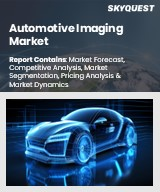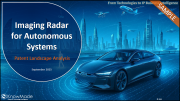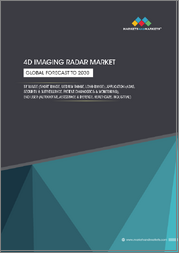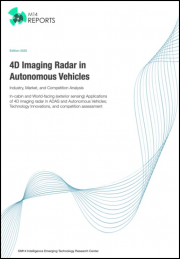
|
시장보고서
상품코드
1771254
자율주행차의 4D 이미징 레이더 시장 - 업계, 시장, 경쟁 분석(2025년판)4D Imaging Radar in Autonomous Vehicles - Industry, Market, and Competition Analysis, Edition 2025 |
||||||
ADAS 및 자율주행차에서 4D 이미징 레이더의 차내 및 차외 센싱 용도, 60GHz, 76-81GHz, 140GHz 대역, SAE 레벨 2+ 이상 용도, 신흥 4D 영상처리 업체들의 경쟁 평가
주요 하이라이트
- ADAS 및 AV 레이더 모듈 시장 규모는 2025년부터 2035년까지 2.7배 확대되어 11.7%의 CAGR로 2025년 90억 달러에서 2035년 250억 달러에 달할 것으로 예상됩니다.
- 4D 이미징 레이더 모듈은 2035년까지 56% 이상 보급될 것으로 예상되며, 현재 시장 보급률 대비 45% 급증할 것으로 예상됩니다.
- 2035년까지 자율주행차의 부상과 비용 절감으로 인해 4D 레이더가 단거리 및 중거리를 독점하고 많은 ADAS 및 AV 시스템에서 기존 3D 레이더를 대체할 가능성이 있습니다.
- 탑승자 모니터와 좌측 어린이 감지장치의 차내 적용은 EURO NCAP과 같은 규제 의무화로 인해 틈새시장으로 성장하고 있습니다.
- TSMC, GlobalFoundries, imec의 140GHz 레이더 기술 개발은 실내외 용도의 고해상도 센싱에 초점을 맞추고 있습니다.
- Continental, Bosch, Vayyar, Arbe, Under, NXP, Tesla 등 주요 기업들이 혁신을 주도하고 있으며, 최근 CES 2025와 IAA Mobility 2025에서 열린 쇼케이스에서는 해상도, 효율성, 규제 대응의 진전을 강조했습니다.
- RFISee, RadSee, Smart Radar System, Zadar Labs, InnoSenT, Infineon, Ainstein은 4D 이미징 레이더 업계의 저명한 스타트업입니다. 한편, Texas Instruments, NXP Semiconductors, STMicroelectronics, Xilinx, Analog Devices는 ADAS(첨단 운전자 보조 시스템) 및 차량 자동화를 지원하는 4D 이미징 레이더 솔루션을 적극적으로 개발하고 있는 선도적인 시스템온칩(SoC) 공급업체입니다.
- 동적 해상도를 구현하는 AI 탑재 소프트웨어 정의 레이더에 집중하는 Zendar Inc., Qamcom Group에서 분사한 Sensrad AB, 빠른 시장 진입에 집중하는 Waveye, 로보택시 및 도심형 AV에 조기 도입하는 Altos Radar, 지역 확대를 위해 중국 OEM(SAIC, Geely 등)과 제휴하는 Altos Radar, 자율주행 셔틀 및 산업용 애플리케이션 등 틈새시장을 공략하는 Xavveo 등의 스타트업이 있습니다.
샘플보기
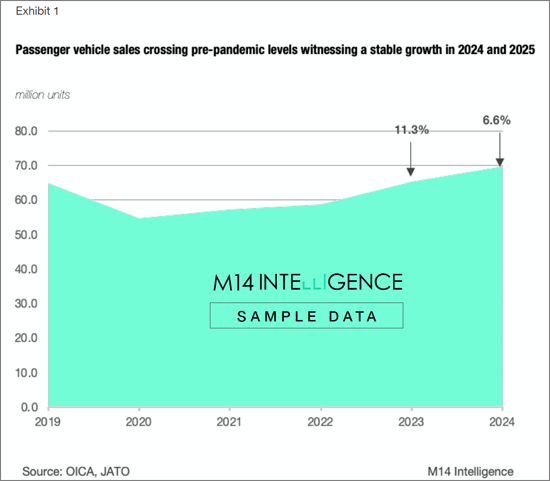
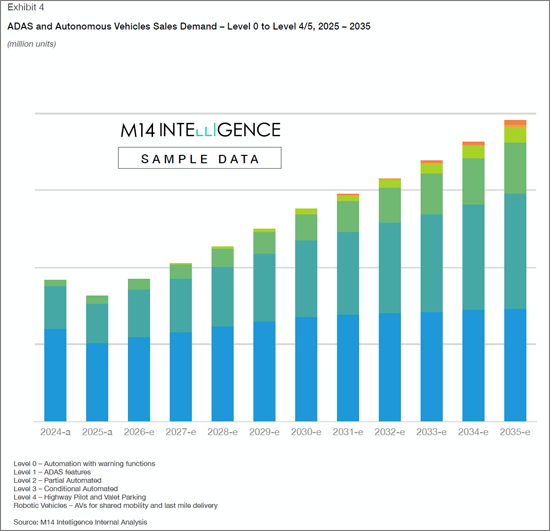
종합적인 범위
M14 인텔리전스는 자율주행, 커넥티드, 전동화, 공유 모빌리티의 주요 동향을 파악하는 능력을 핵심으로 하는 4D 이미징 레이더 기술에 대한 조사 결과를 발표했습니다.
- ADAS, 자율주행차, 로봇 자동차 - 시장 전망
- ADAS 및 AV 산업에서 레이더 센서의 현재 상황
- 자동화 수준(ADAS, 레벨2/2+, 레벨3, 레벨4/5), 동작 범위(단거리, 중장거리), 동작 주파수 대역(60GHz, 76-81GHz, 140GHz) 등 다양한 관점에서 레이더 수요의 잠재적 변화 및 시장 규모 파악
- 변조 기술 - FMCW 및 디지털 코드 변조(DCM)
- 레이더 온칩 및 MIMO 안테나 설계
- AI 기반 처리
- 차량 내부 및 전 세계 차량 외부 센싱용 4D 이미징 레이더 온칩 센서 시장 침투 동향
- 지역별 주파수 규제 및 할당 영향
- 4D 이미징 레이더의 하드웨어 칩 및 소프트웨어 솔루션과 센서 제품군 다이나믹스에 대한 도전과제를 제시
- AI 통합, 레이더 온 칩, 센서 퓨전 등 시장을 재편하는 파괴적 트렌드
- 높은 비용과 통합의 복잡성과 같은 과제와 반도체 및 소프트웨어 정의 레이더의 발전이 이러한 장애물을 어떻게 해결하고 있는가?
- 자동차 레이더 시장에서 솔루션을 제공하는 칩 제공업체 및 티어1 기업의 전략 및 시장 개척과 함께 신흥 리더 기업 및 신생 기업의 경쟁 평가.
시장 개요
자율주행 차량용 4D 이미징 레이더 시장은 첨단운전자보조시스템(ADAS)과 자율주행차(AVs)의 진화를 촉진하고 자동차 기술 혁신의 최전선에 있습니다. 2024년 시장 규모는 약 20억 달러, 2030년에는 100억 달러에 달할 것으로 예상되며, CAGR은 38%에 달할 것으로 예상됩니다. 이는 안전성 향상에 대한 수요 증가, 규제 의무화, 더 높은 자율주행 수준(SAE 레벨 4/5)의 추진에 기인합니다.
본 보고서에서는 ADAS와 AV에서의 레이더 센서의 채용, 3D 레이더를 대체하는 4D 레이더의 보급, 현재와 미래의 레이더 기술과 주파수 대역, 주요 기업 및 스타트업, 경쟁 전략, 최근 동향, AV에서 4D 레이더의 중요한 역할, 로보택시 및 셔틀 시장 개척 가능성에 대해 아시아태평양 등 미래성이 높은 지역을 중심으로 조사하고 있습니다.
ADAS 및 자율주행차의 레이더 센서 채용
레이더 센서는 ADAS와 AV에 필수적이며, 어댑티브 크루즈 컨트롤(ACC), 자동 긴급제동(AEB), 사각지대감지(BSD), 차선변경 보조(LCA), 어린이 존재 감지(CPD))와 같은 중요한 기능을 가능하게 합니다. 카메라나 LiDAR와 달리 레이더는 악천후(안개, 비, 눈 등)나 저조도 환경에서도 뛰어난 성능을 발휘하여 신뢰할 수 있는 물체 감지 및 거리 측정이 가능합니다. 2024년에는 전 세계적으로 1억 6,900만 개 이상의 레이더 센서가 출하되어 2024년에는 차량 1대당 평균 0.8개의 장거리 레이더가 장착되었으며, 2030년에는 차량 1대당 1개의 장거리 레이더가 탑재될 것으로 예상됩니다. Cruise(1대당 21개의 레이더) 및 Waymo(6개의 고성능 4D 레이더) 등의 Robotaxis는 레벨 4/5의 자율성을 위해 레이더에 대한 의존도가 높으며, 견고한 환경 인식을 보장하고 있습니다. 안전에 대한 소비자의 요구와 규제 의무화(EU 자동차 일반 안전 규정, 2024년 7월 등)에 힘입어 ADAS의 채택이 증가하고 있으며, 승용차, 상용 트럭, 자율주행 셔틀에 대한 레이더 배치가 가속화되고 있습니다.
3D 레이더를 대체하는 4D 레이더 기술 보급
3D 레이더의 범위, 방위, 도플러 데이터에 속도와 고도를 더한 4D 이미징 레이더는 뛰어난 해상도와 정확도로 인해 기존 레이더를 빠르게 대체하고 있습니다. 2025년까지 4D 레이더는 자동차 레이더 시장의 11.4%에 침투하여 2-3년 내에 틈새기술에서 주류기술로 전환될 것으로 예상됩니다. 고각 해상도나 복잡한 물체 분리(보행자와 차량 구분 등)에 어려움을 겪는 3D 레이더와 달리, 4D 레이더는 Massive MIMO, DCM(디지털 코드 변조), AI 기반프로세싱을 활용하여 고해상도 점군을 생성하고, 일부 응용 분야에서는 LiDAR에 필적할 수 있습니다. 예를 들어, 드라이브 파일럿이 탑재된 Mercedes-Benz EQS나 Continental의 ARS540 4D 레이더를 장착한 현대 아이오닉 5는 시야가 좋지 않은 곳에서의 성능 향상을 보여주고 있습니다. 이러한 변화는 레벨 3-5의 자율주행에서 정확한 인식의 필요성과 교차로 보행자 AEB와 같은 첨단 안전 기능에 대한 규제 요건에 의해 추진되고 있습니다.
경쟁 전략 및 지역 시장 기회
기존 진입 기업들은 고해상도 레이더와 LiDAR/카메라의 센서 융합에 초점을 맞춘 연구개발, 세계 입지, OEM 파트너십(예: Bosch와 Volkswagen과의 협업)을 활용하고 있습니다. 반면, 스타트업은 비용 효율적인 설계(RadSee의 COTS, Under의 RoC), AI 통합(Waveye, Zendar), 틈새 애플리케이션(Sensrad의 산업용 포커스)으로 차별화를 꾀하고 있습니다. Tier 1 및 OEM(예: Arbe-BAIC)과의 제휴라는 협력적 접근 방식이 신규 진입 기업의 시장 진입을 가속화하고 있습니다.
아시아태평양은 중국의 전기자동차 붐과 정부의 스마트 시티 지원에 힘입어 가장 높은 CAGR로 가장 빠르게 성장하는 지역입니다. SAIC와 NIO와 같은 기업들은 4D 레이더를 통합하고 있습니다(예: ZF와 SAIC의 제휴(2022년 12월)). 북미는 Ford, GM, Tesla 등의 OEM들이 BlueCruise, Super Cruise, Autopilot에 4D 레이더를 채택하고 있으며, 미국이 주도하여 가장 큰 매출 점유율을 차지하고 있습니다. 유럽은 엄격한 안전 규제(EU의 2024년 의무화 등)로 인해 강력한 성장세를 보이고 있습니다. 예를 들어 Mercedes-Benz와 BMW는 레벨 2+/3 시스템에서 선두를 달리고 있으며, 그 기회는 프리미엄 자동차 및 컴플라이언스 중심 시장에 분명하게 반영되어 있습니다.
시장 가능성
로보택시와 셔틀을 포함한 SAE 레벨 4/5 AV 시장은 4D 레이더의 주요 성장 요인입니다. Cruise와 Waymo는 4D 레이더를 광범위하게 배치하고 있으며, 2024년에는 1,000대 이상의 차량을 보유해 상업용 로보택시 서비스의 부상을 시사하고 있습니다. 전 세계 4D 레이더 시장은 레벨 4/5 AV에서만 2035년까지 9억 1,100만 달러에 달할 것으로 예상되며, 로보택시와 셔틀이 도시와 고속도로의 자율주행에 많은 양의 레이더 유닛을 소비할 것으로 예상됩니다.
기회에는 다음이 포함됩니다:
- 도시 이동성 : 밀집된 환경을 탐색하기 위한 높은 레이더 수요(예: 웨이브아이의 도시 전문 레이더).
- 라스트 마일 배송 : 안전을 위해 4D 레이더를 채택한 자율주행 셔틀과 배송 차량.
- 규제 지원 : AEB와 CPD의 의무화로 인해 레벨 4/5 시스템에 레이더 통합이 진행됩니다.
주요 질문
- SAE 레벨 1-5 자율주행차에 4D 영상레이더의 보급 속도와 도입 동향은?
- 2035년까지 자동차용 4D 이미징 레이더 시장의 현재 시장 규모와 성장 가능성은?
- 4D 레이더에 가장 많이 의존하는 ADAS 기능(AEB, ACC, BSM 등)과 그 안전성과 성능 향상은?
- 4D 레이더의 비용(77GHz, 60GHz, 140GHz 등)은 어떻게 진화하고 있는가?
- 4D 레이더와 다른 센서(LiDAR, 카메라 등)를 통합하여 견고한 센서 융합을 실현하기 위한 과제는 무엇인가?
- 주파수 규제(77GHz, 60GHz, 140GHz 등)는 전 세계적으로 어떻게 다르며, 4D 레이더 배치에 어떤 영향을 미치는가?
- 4D 레이더가 탑승자 감시, 좌회전 감지 등 차량 내 감시에서 차지하는 역할은 어떻게 시장 기회를 창출하고 있는가?
- 4D 레이더 시장을 파괴하고 있는 스타트업(Arbe, Under, Zendar 등)과 그들의 독특한 전략은 무엇인가?
- 4D 레이더 시장에서 기존 기업(Continental, Bosch, NXP 등)과 스타트업의 경쟁 우위는?
- 파트너십, M&A는 4D 레이더 시장을 어떻게 형성하고, 이해관계자들에게 어떤 기회를 가져다 줄 것인가?
- 4D 레이더 시장의 성장을 뒷받침하는 투자 및 자금 조달 동향과 이해관계자들은 이를 어떻게 활용할 수 있을까?
4D 이미징 레이더 업계에서 가장 흥미로운 질문에 대한 해답을 얻을 수 있습니다!
기업 목록
|
|
목차
승용차 판매 - 시장 전망
- 세계의 승용차 판매대수(2019-2024년)
- 승용차 판매 내역(자동화 레벨별, L1-L5)
- ADAS 및 자율주행차 시장 매출과 예측, 2025-2035년
- 중국이 시장을 독점하고, 유럽은 높은 성장의 잠재력을 가지고 있다.
- 도시 교통, 라스트 마일 배송, 규제 지원이 새로운 수익원이 된다.
자동차 레이더 산업 현황 - 시장 전망, 수량과 가치, 2025-2035년
- 차량당 레이더 센서 요건
- 레이더의 평균판매가격과 예상되는 가격 하락
- 자동화 레벨별 레이더 수요
- 운영 범위별 레이더 수요(LRR, MRR/SRR, 캐빈내)
- 주파수별 레이더 수요
- 주파수별 레이더 시장 침투율
- 4D 이미징 레이더 동향이 빠르게 확대
자동차용 4D 레이더 산업 - 시장 전망, 수량과 가치, 2025-2035년
- 4D 레이더 시장 - 자동화 레벨별
- 4D 레이더 시장 - ADAS와 AV 용도별
- 외부 센싱 애플리케이션용 4D 이미징 레이더
- 차량내 애플리케이션용 4D 이미징 레이더
자동차 4D 레이더 업계 - 경쟁 평가
- 자동차용 4D 레이더 응용의 신흥 기업 프로파일
- 제품의 비교와 벤치마크
- 파트너십 매핑과 공급업체 분석
- 4D 레이더 사업의 OEM, Tier 1, 센서 공급업체
- 주요 기업별 연구개발에 대한 투자
- 4D 레이더 사업의 스타트업 자금 조달·투자 분석
In-cabin and Exterior Sensing Applications of 4D imaging radar in ADAS and Autonomous Vehicles; 60 GHz, 76-81 GHz, and 140 GHz Band, SAE Level 2+ and above applications, Emerging 4D imaging players competition assessment.
Key Highlights
- ADAS and AV radar module market size anticipated to grow 2.7x times between 2025 to 2035, accounting $25 billion in 2035 from $9 billion by 2025 at a CAGR of 11.7 percent
- 4D imaging radar modules expected to penetrate over 56 percent by 2035, a jump of 45% from the current market penetration
- By 2035, with the rise of autonomous vehicles and cost reductions, 4D radar could dominate short- and medium-range applications, potentially replacing conventional 3D radar in many ADAS and AV systems
- The in-cabin applications of occupant monitoring and left-child detection is a growing niche due to regulatory mandates like those from EURO NCAP
- Development of 140 GHz radar technology by TSMC, GlobalFoundries, and imec focuses on high-resolution sensing for both interior and exterior applications, though not yet commercialized, the technology is expected to strongly compete with 77GHz system by 2035
- Leading companies like Continental, Bosch, Vayyar, Arbe, Uhnder, NXP, and Tesla are driving innovation, with recent showcases at CES 2025 and IAA Mobility 2025 highlighting advancements in resolution, efficiency, and regulatory compliance.
- RFISee, RadSee, Smart Radar System, Zadar Labs, InnoSenT, Infineon, and Ainstein are prominent emerging players in the 4D imaging radar industry. Meanwhile, Texas Instruments, NXP Semiconductors, STMicroelectronics, Xilinx, and Analog Devices are leading System-on-Chip (SoC) providers actively developing 4D imaging radar solutions to support Advanced Driver Assistance Systems (ADAS) and higher levels of vehicle automation.
- Emerging start-ups such as Zendar Inc. focusing on software-defined radar with AI for dynamic resolution, Sensrad AB is a spin-out from Qamcom Group, focusing on rapid market entry, Waveye is targeting early adoption in robotaxis and urban AVs, Altos Radar partnering with Chinese OEMs (e.g., SAIC, Geely) for regional expansion, Xavveo is targeting niche markets like autonomous shuttles and industrial applications
SAMPLE VIEW


Countries Covered: Global (China, India, Japan, South Korea, US, Canada, South America, Germany, France, Italy, UK, Israel, others).
Exhaustive Coverage
M14 Intelligence with its core capabilities in understanding the key trends of autonomous, connected, electric, and shared mobility published the research on 4D imaging radar technology which talks about following important factors of the market.
- ADAS, Autonomous and Robotic Vehicles - Market Outlook
- Status of radar sensors in the ADAS and AV industry
- Understanding the potential change in the radar demand and its market size from different perspectives including - automation levels (ADAS, Level 2/2+, Level 3 and Level 4/5), range of operations (short, medium-long), and frequency band of operation (60 GHz, 76-81 GHz , and 140GHz)
- Modulation Techniques- FMCW and Digital Code Modulation (DCM)
- Radar-on-Chip and MIMO antenna design
- AI-based processing
- Market penetration trend of 4D imaging radar-on-chip sensors for in-cabin and world-facing exterior sensing applications
- Impact of frequency regulations and allocations across different geographies
- 4D imaging radar hardware chip and software solutions and how it is expected to challenge the sensor suite dynamics
- Disruptive trends like AI integration, radar-on-chip, and sensor fusion that will reshape the market
- Challenges like high costs and integration complexities, and how advancements in semiconductors and software-defined radar are addressing these hurdles
- Competition assessment of emerging leaders and start-ups, along with the strategies and developments of chip providers and tier-1s offering solutions in automotive radar market.
Market Overview
The 4D imaging radar market for autonomous vehicles is at the forefront of automotive innovation, driving the evolution of Advanced Driver Assistance Systems (ADAS) and autonomous vehicles (AVs) . Valued at approximately USD 2 billion in 2024, the market is projected to reach USD 10 billion by 2030, with a CAGR of 38%, fueled by the increasing demand for enhanced safety, regulatory mandates, and the push for higher autonomy levels (SAE Level 4/5).
This report summary explores the adoption of radar sensors in ADAS and AVs, the penetration of 4D radar replacing 3D radar, current and future radar technologies and frequency bands, leading and emerging players, competitive strategies, recent developments, the critical role of 4D radar in AVs, and market potential for robotaxis and shuttles, with a focus on high-potential regions like Asia-Pacific.
Adoption of Radar Sensors in ADAS and Autonomous Vehicles
Radar sensors are integral to ADAS and AVs, enabling critical features like Adaptive Cruise Control (ACC), Automatic Emergency Braking (AEB), Blind Spot Detection (BSD), Lane Change Assist (LCA), and Child Presence Detection (CPD) . Unlike cameras and LiDAR, radar excels in adverse weather conditions (e.g., fog, rain, snow) and low-light scenarios, providing reliable object detection and ranging. In 2024, over 169 million radar sensors were shipped globally, with an average of 0.8 long-range radars per vehicle in 2024, expected to approach 1 per vehicle by 2030. Robotaxis, such as Cruise (21 radars per vehicle) and Waymo (six high-performance 4D radars), demonstrate heavy reliance on radar for Level 4/5 autonomy, ensuring robust environmental perception. The rising adoption of ADAS, driven by consumer demand for safety and regulatory mandates (e.g., EU's Vehicle General Safety Regulations, July 2024), is accelerating radar deployment across passenger vehicles, commercial trucks, and autonomous shuttles.
Penetration of 4D Radar Technology Replacing 3D Radars
4D imaging radar, which adds velocity and elevation to the range, azimuth, and Doppler data of 3D radar, is rapidly replacing its predecessor due to superior resolution and accuracy. By 2025, 4D radar is expected to penetrate 11.4% of the automotive radar market, transitioning from a niche to a mainstream technology within 2-3 years. Unlike 3D radar, which struggles with elevation resolution and complex object separation (e.g., distinguishing a pedestrian from a vehicle), 4D radar leverages Massive MIMO, Digital Code Modulation (DCM) , and AI-driven processing to create high-resolution point clouds, rivaling LiDAR in some applications. For instance, Mercedes-Benz EQS with Drive Pilot and Hyundai IONIQ 5 with Continental's ARS540 4D radar showcase enhanced performance in poor visibility. The shift is driven by the need for precise perception in Level 3-5 autonomy and regulatory requirements for advanced safety features like Junction Pedestrian AEB.
Competitive Strategies and regional market opportunities
Established players leverage R&D, global presence, and OEM partnerships (e.g., Bosch's collaboration with Volkswagen) focusing on high-resolution radar and sensor fusion with LiDAR/cameras. On the other hand, start-ups differentiate through cost-effective designs (RadSee's COTS, Uhnder's RoC), AI integration (Waveye, Zendar), and niche applications (Sensrad's industrial focus). A collaborative approach is wherein partnership with Tier 1s and OEMs (e.g., Arbe-BAIC) is accelerating market entry for new players.
Asia-Pacific is the fastest-growing region with the highest CAGR, driven by China's EV boom and government support for smart cities. Companies like SAIC and NIO integrate 4D radar (e.g., ZF's partnership with SAIC, Dec 2022). Opportunities lie in mass-market EVs and robotaxi fleets in urban centers like Shanghai. North America holds largest revenue share, led by the US with OEMs like Ford, GM, and Tesla adopting 4D radar for BlueCruise, Super Cruise, and Autopilot. Europe shows strong growth due to stringent safety regulations (e.g., EU's 2024 mandates). For instance, Mercedes-Benz and BMW lead with Level 2+/3 systems and opportunities are evidently reflected in premium vehicles and compliance-driven markets.
Market Potential
The market for SAE Level 4/5 AVs, including robotaxis and shuttles, is a key growth driver for 4D radar. By 2035, the AV segment is expected to exhibit the highest CAGR (127%) from 2025 to 2035 within the 4D radar market, driven by the need for multiple high-performance radars (6-21 per vehicle). Cruise and Waymo deploy 4D radar extensively, with fleets exceeding 1,000 vehicles in 2024, signaling commercial robotaxi services' rise. The global 4D radar market is projected to reach USD 911 million by 2035 for Level 4/5 AVs alone, with robotaxis and shuttles consuming significant radar units for urban and highway autonomy.
Opportunities include:
- Urban Mobility: High radar demand for navigating dense environments (e.g., Waveye's urban-focused radar).
- Last-Mile Delivery: Autonomous shuttles and delivery vehicles adopting 4D radar for safety.
- Regulatory Support: Mandates for AEB and CPD boost radar integration in Level 4/5 systems.
Key Questions Answered:
- How rapidly is 4D imaging radar penetrating autonomous vehicles across SAE Levels 1-5, and what are the adoption trends?
- What is the current market size and growth potential of the 4D imaging radar market for automotive applications through 2035?
- Which ADAS features (e.g., AEB, ACC, BSM) are most reliant on 4D radar, and how do they enhance safety and performance?
- How are 4D radar costs (e.g., 77 GHz, 60 GHz, 140 GHz) evolving, and what factors drive cost erosion for mass production?
- What are the challenges of integrating 4D radar with other sensors (e.g., LiDAR, cameras) for robust sensor fusion?
- How do frequency regulations (e.g., 77 GHz, 60 GHz, 140 GHz) vary globally, and what impact do they have on 4D radar deployment?
- How 4D radar's role in in-cabin monitoring applications of occupant monitoring and left-child detection is creating market opportunity?
- Which emerging startups (e.g., Arbe, Uhnder, Zendar) are disrupting the 4D radar market, and what are their unique strategies?
- What are the competitive advantages of established players (e.g., Continental, Bosch, NXP) versus emerging startups in the 4D radar market?
- How are partnerships, mergers, and acquisitions shaping the 4D radar market, and what opportunities do they create for stakeholders?
- What investment and funding trends are supporting the growth of the 4D radar market, and how can stakeholders capitalize on them?
Get answers to the most intriguing questions in the 4D imaging radar industry!
List of Companies
|
|
Table of Contents
Passenger Vehicle Sales - Market Outlook
- Global Passenger Vehicle Sales, 2019-2024
- Passenger Vehicle Sales Breakdown, by Level of Automation, L1 to L5
- ADAS and Autonomous Vehicle Market sales and forecast, 2025-2035
- China dominating the market while Europe holds strong growth potential
- Urban mobility, last-mile delivery and regulatory support will be the new revenue pockets
Status of Automotive Radar Industry - Market Outlook Volume & Value, 2025-2035
- Radar Sensor requirement per vehicle
- ASP of Radar and Expected Price Erosion
- Radar Demand by Levels of Automation
- Radar Demand by Range of Operation (LRR, MRR/SRR, In-cabin)
- Radar Demand by Frequency
- Radar Market Penetration by Frequency
- Trend towards 4D Imaging Radar is Growing Rapidly
Automotive 4D Radar Industry - Market Outlook Volume & Value, 2025-2035
- 4D Radar Market - Split by Levels of Automation
- 4D Radar Market - Split by ADAS and AV Applications
- 4D Imaging Radar for Exterior Sensing Application
- 4D Imaging Radar for In-cabin Application
Automotive 4D Radar Industry - Competition Assessment
- Profiles of Emerging Companies in Automotive 4D Radar Application
- Product Comparison and Benchmarking
- Partnership Mapping and Supplier Analysis
- OEMs, Tier-1s, and Sensor Suppliers in 4D Radar Business
- Investment in R&D by leading players
- Funding and Investment Analysis of Start-ups in 4D Radar Business






